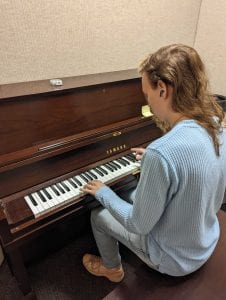Score:
Sit down with an instrument
Pick a song you would like to play with your instrument
Prepare to play an audio recording of your song
Remove yourself from the noise of the outside world such that you hear the instrument as little as possible when played
Prepare to play the instrument correctly as you have done before
Play your song to completion while listening to your recording
Artist Statement:
“Maestro for a Moment” was created with two pieces of inspiration in mind. The first form of inspiration is a passive desire of mine that I’ve had for a while: to learn to play the piano. I call it “passive” because, while I think the idea of being able to play the piano well is a fun one, I actually don’t care enough about it to put in the multiple years of effort it would take to learn it on a professional level. In my mind, it has always been restricted to passing an open piano at a mall, an airport, or even the Curry Student Center, and just thinking, “Wouldn’t it be nice?”
The second inspiration was David Tudor who was known for composing indeterminate pieces, such as Imaginary Landscape No. 4 (1951) and Music of Changes (1951). An indeterminate music piece is one that introduces some level of chance to the musical score so that creates an indeterminable outcome, one that is unique to each performance of the piece. I thought this was fascinating due to how it changes the fundamental idea of a musical performance. When one thinks of a concert, they typically think of a musician practicing a set of instructions, the musical score, to produce some kind of expected outcome, the song. David Tudor entertained the thought of changing that formula to produce an unexpected outcome rather than an expected one; from instructed input and expected output to instructed input and unexpected output.
With these two things in mind, I constructed this score to evoke a feeling into the person performing it: that they can play an instrument they don’t actually know how to play. I did this through playing with that formula of performance much like the way David Tudor did, except I reversed the changes he made to it. Instead of an instructed input with an unexpected output, this score displays an uninstructed input with an expected output. The uninstructed input is the user’s ability (or lack thereof) to play the instrument “correctly.” What “play[ing] the instrument correctly” really means is to just play the instrument in a way that feels correct to the user. Whether or not that is actually correct doesn’t matter, because by removing their ability to hear the music they are physically playing and replacing it with a recording of the song they actually want to play (the expected output), they feel like they are producing the music with their instrument that they are listening to.
While not intended to be so, some participants took to making this into a performative piece instead of a personal one by wanting to record the actual music they created with their instrument to play it back for themselves and others. This doesn’t fall in-line with the feeling I wanted to evoke in this score, so I didn’t want to enforce this instruction. However, because this is supposed to be a personal score, I would encourage anyone wanting to play this score to do whatever they wish with what they create.


